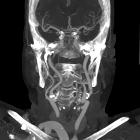High-riding brachiocephalic artery







A high-riding brachiocephalic artery (now preferred to innominate artery) is a rare anomaly of the neck vessels in which the brachiocephalic artery passes much more superiorly than normally. It is a clinically important variant, as mistaking it for a neck lump and sampling it or neck surgery in the region may cause a devastating hemorrhage .
Epidemiology
High-riding brachiocephalic artery is a rare occurrence. There are only a handful of case reports in the medical literature .
Clinical presentation
Most instances are asymptomatic and detected incidentally at neck surgeries such as tracheostomy, thyroidectomy or other laryngeal surgeries. Some may present as a pulsatile neck lump just below the level of the thyroid gland. Some cases may present as stridor due to tracheal compression .
Radiographic features
Ultrasound with Doppler interrogation is an efficient and accessible method to assess it and is usually the initial study. It will show the bifurcation of the brachiocephalic artery into the right common carotid artery and right subclavian artery located superior to the right sternoclavicular joint (normally located behind it). The bifurcation can be as high as the inferior part of the right lobe of the thyroid gland.
CT, MRI, and angiography will show further details as the brachiocephalic artery ascends above the thoracic inlet before bifurcating.
Development
The brachiocephalic artery originates from incorporation by the right fourth aortic arch and persistence of a proximal additional part of the right fourth innominate artery, leading to elongation of the artery .
Siehe auch:

 Assoziationen und Differentialdiagnosen zu bis zervikal hoch stehender Truncus brachiocephalicus:
Assoziationen und Differentialdiagnosen zu bis zervikal hoch stehender Truncus brachiocephalicus:


